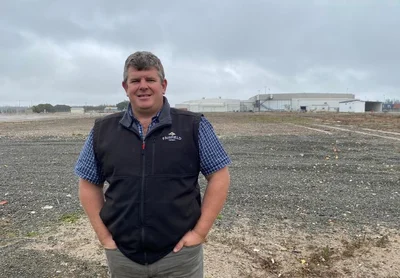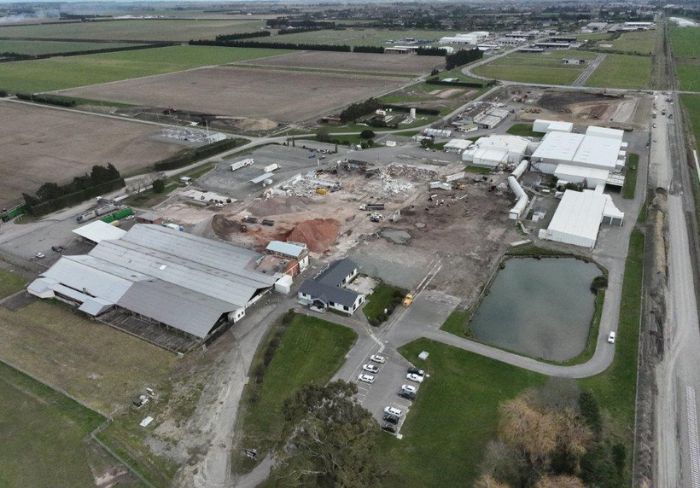Economic growth from fallen freezing works

Ashburton's freezing works was an economic powerhouse for more than 100 years until its closure in 2019. Now, plans are underway to resurrect the old site. Reporter Jonathan Leask delves into its history and what the future may hold.
Fairton has a long history of being a key economic centre for the Ashburton District.
For over 100 years it was home to the freezing works.
It provided jobs in the region and economic benefits until it closure in 2019.
It is now being resurrected as a commercial land of opportunity to return to its former glory as a key pillar in the district.
Talley’s general manager of Fairfield, farming, and freight Aaron Chudleigh said the company took over the former Silver Fern Farms site in 2020 after seeing its regional potential.
“With a substantial business already here, the site allowed us to future-proof our position in the district.”
The company decided to buy the former works site due to the existing rail siding, cold storage, effluent discharge, farmland and water, as well as the location making it a viable option for expansion.

The site is close to the existing vegetable production plant, and Talley’s was already leasing the cold stores for storing its vegetables.
Purchasing the site allowed Talley's to establish Fairfield Farms, separating the farming operations from the vegetable production.
Fairfield Farms uses the 485 hectares of land for growing crops but not the around 30 hectares of the freezing works plant.
When Talley’s purchased the site it was with plans to demolish much of the old freezing works.
“There was a lot of earthquake damage and a lot of the older buildings just weren’t up to standard or compliant.
“When you become a new owner you have to bring the buildings up to code before you can operate them.”
Talley’s had no plans to operate the site as a freezing works because of a covenant preventing meat production for 50 years, Chudleigh said.
Facing expensive compliance work to refurbish and retain buildings they weren’t able to use, the only sensible option was demolition, Chudleigh said.
Of the freezing works building footprint “somewhere between a third and a half” has been retained – including the cool stores, amenities block, and the works office.
“Pretty much everything that was built after the 1970s has been kept.”

Southern Demolition completed the demolition, starting in 2022, and was responsible for the asbestos removal and recycling materials, Chudleigh said.
“The big thing was to first get the demolition done properly and then to get the freight hub going.
“Now we can look at what to do with the rest of the site.
“We have some consultants engaged and we have been in discussion with the council around zoning and what could be out here.”
They have options for the around 30 hectares, the leading contender of which would be a business park to support and service the freight hub, he said.
“That’s our aim but it’s still in the early stages.”
Ashburton Mayor Neil Brown is supportive of Talley’s work towards expanding its operations and revitalising the site at Fairton.
“It all ties in with the economic development of the district and growing our economy, which means more jobs.”
The historic significance of the site isn’t being ignored.
“We are aware of our footprint and presence in the district, and want to keep some of the history alive,” Chudleigh said.
Talley’s is working with Historic Places Mid Canterbury to install some interpretive panels to detail the history of the site next to the Fairton Hall.
Ashburton District Councillor Carolyn Cameron, who chairs the Historic Working Group, said she is pleased "the history of this site is maintained and acknowledged”.
“The Fairton works site has great significance to our agricultural history and the place where many in the district have connections.
“It is important to acknowledge the significance of this site.”

The Fairfield Freezing Works opened in March 1899 in what was a significant addition to Ashburton's economy.
Sheep farming was a cornerstone of the Canterbury economy in the late 1800s when the then Fairfield Freezing Works, owned by the Canterbury Frozen Meat Company (CFM), played an important part in processing sheep meat for Britain.
The Cyclopaedia of New Zealand (1903) stated the works were considered to be the finest in the Southern Hemisphere, and put through 500 sheep in a day, and had a storage capacity for 80,000 carcases.
The co-operative went on to become PPCS (Primary Producers Co-operative Society) and later Silver Fern Farms.
The Fairton plant was one of the biggest employers in the Ashburton district for 125 years.
At its peak, the plant was a three-chain sheep meat operation employing more than 700 staff.
Silver Fern Farms closed its Fairton sheep meat processing plant In May 2017, affecting 370 staff.
In the face of declining sheep numbers, Silver Fern Farms said at the time that Fairton was unprofitable and its closure meant it could consolidate volume at its Pareora site south of Timaru.
It then closed then closed its pelt processing plant, affecting 48 staff, in 2019.
The site then went on the market in 2020 offering 485 hectares of land, comprising 32ha at the former Fairton plant and 453ha of adjacent rural land.
Talley’s purchased the site in 2020.

Freight Hub formation
The sales pitch from real estate agency, Colliers, stated that “astute buyers with logistics in mind will appreciate the prized position of the Fairton Plant, bordering the Ashburton Business Estate and featuring over 1km of Main South rail line frontage”.
“Situated approximately halfway between the ports of Lyttelton and Timaru, it’s easy to see the appeal for large-scale producers and exporters.”
Being in charge of logistics, Chudleigh had the vision for utilising the siding to put Talley’s produce on rail.
Meanwhile, Wareing Group director Mark Wareing had a similar vision of adding a rail siding at the Rural Transport yard just down from the old freezing works.
“We were having a chat one day and realised we had similar goals and there was no point us both doing it but we saw it as a real opportunity for Ashburton,” Chudleigh said.
Some discussions over a post-Covid lockdown beer between Chudleigh and Wareing in 2020 were the catalyst to the eventual collaboration on the Fairfield Freight Hub.
“Talley’s weren’t going to have enough volume out of one plant to efficiently run a train out of here but Mark, being an independent transport operator, could make it viable.”
The commercial partnership with Talley’s as the landlord and the Wareing Group’s Fairfield Freight Hub as the tenant received funding from the Government and the Ashburton District Council.
The council contributed $2.3m from its Three Waters Reform Better Off funding package, and the Government chipped in with $2.5m from NZ Transport Agency Waka Kotahi’s upgrade programme.
Construction began in 2023 and the hub became operational this month.
Fairton or Fairfield?
The name Fairton was an ingenious solution according to the Ashburton Museum. There had been some early confusion about the place name, as for a while both the railway siding and the freezing works were called Fairfield. As it was sometimes mistaken for the Fairfield area near Dunedin, the name Fairton was adopted by the community and later by the works as well. In a throwback to the origins of the site, Talley’s farming operation and the freight hub have both used Fairfield.
By Jonathan Leask

